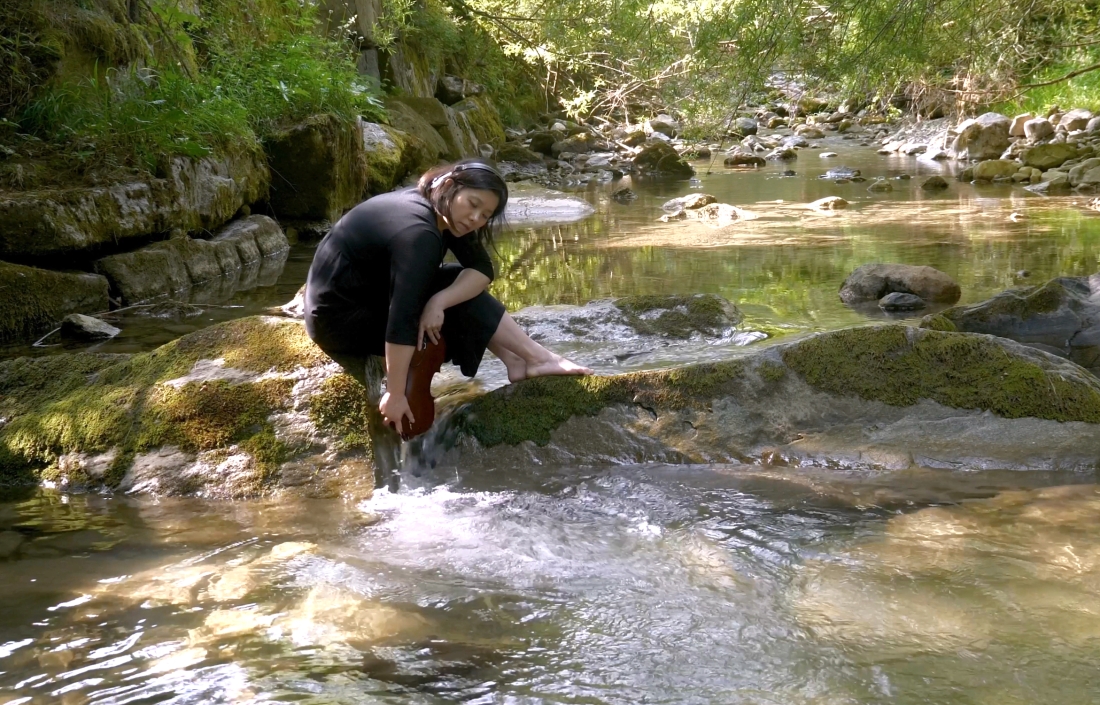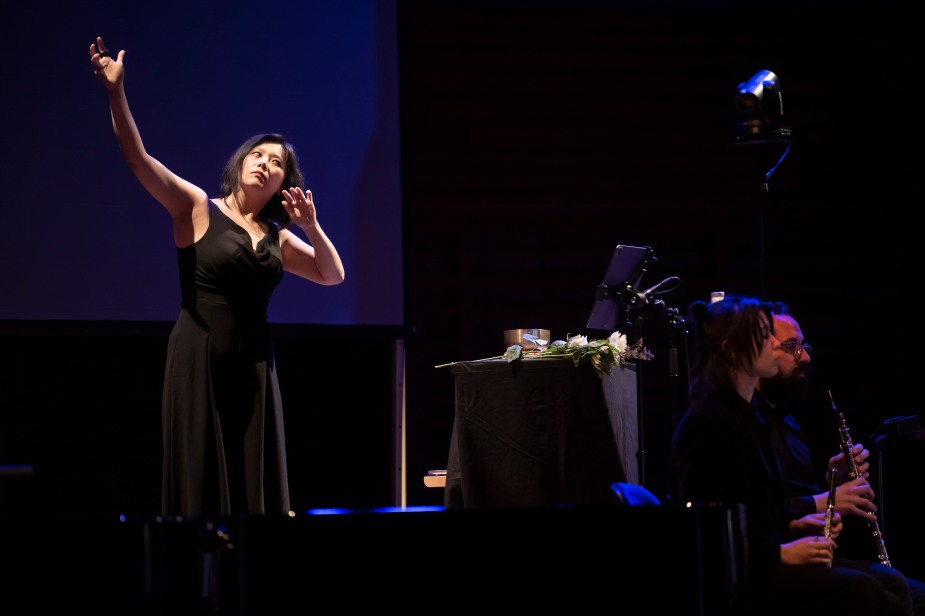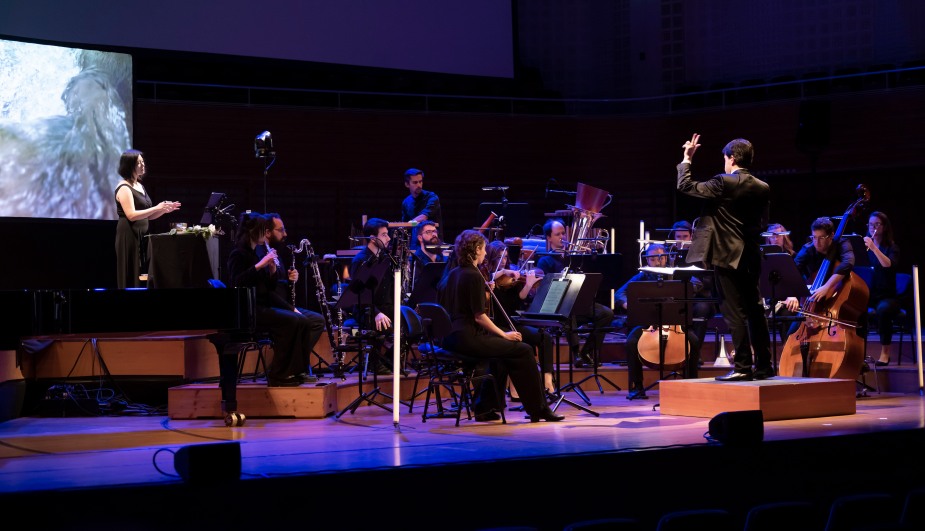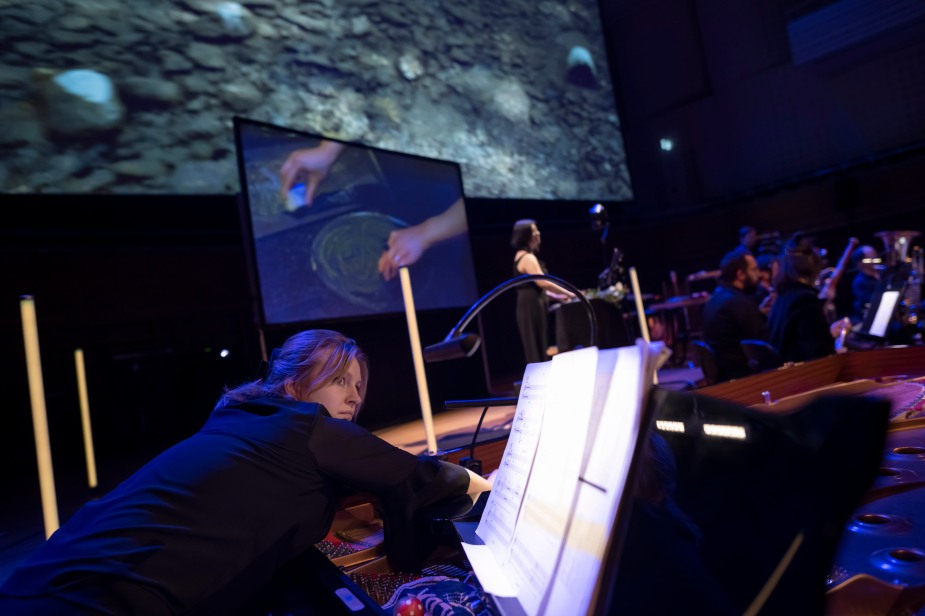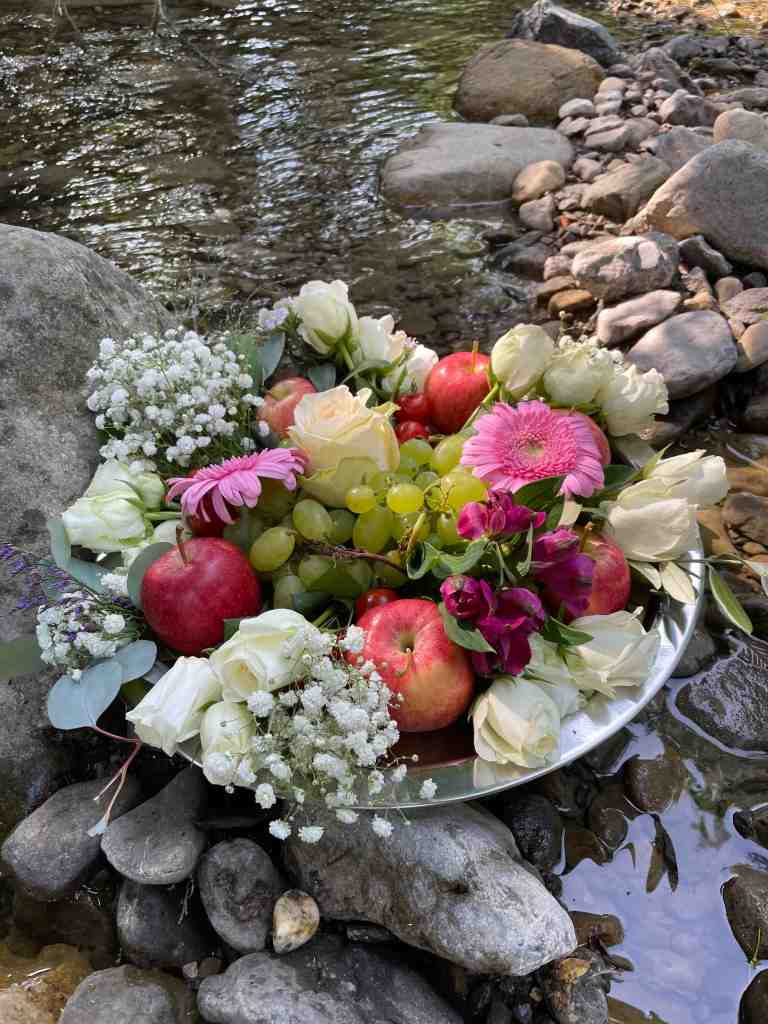This is Part 2 of the ARTikulationen keynote talk given at Künstuniversität Graz entitled ‘Who are we and who else is here (Multispecies Knots of Ethical Time)‘ (see previous post for Part 1). This continues my speculations on the sentiency, the vitality of the more-than-human in a partnership with musical energies. Multispecies Knots of Ethical Time (2023) was commissioned by the Lucerne Festival for gestural performer Winnie Huang, 15 musicians and film. The film is of a collaboration with a river, specifically the Eigenthal-Rümlig that flows in the Eigenthal valley below the Pilatus mountain just outside of Lucerne in Switzerland.
This is a work about time and about ecological connection. The protagonist is the river—a symbol for transience and (endangered) continuity. In videos by Swiss artist Morena Barra, the performer Winnie Huang communicates with the life-worlds of the river. The River Being and its voices are then brought onto a stage through films and recordings. For me, this is a meditation on the possibility of a radical imagination of otherness and an expanded sense of personhood. I see this work as part of a larger project to join the arts to wider movements of multispecies justice that take up the moral, political and legal claims of animals, plants, rivers, forests and ecosystems, as bound up with the fate and well-being of humans.
Environmental Personhood
In 2008 the Ecuadorian constitution enshrined the ‘Rights of Nature’ (Pachamama) giving momentum to a global movement to recognise environmental personhood. (Berros 2015) The idea of a river having personhood and therefore natural and legal rights “represents a seismic shift from the bedrock belief in Western society that humans are at the apex of the natural world” (Berge 2022) But many Indigenous groups already regard rivers as ancestors and kin. Through the activism of Maori leaders, the Whanganui River on New Zealand’s North Island was the first river to be recognised with legal personhood in 2017 which was followed by other declarations of legal personhood for rivers in India, Columbia, Bangladesh and Canada. This legal tool is being used to recognise natural and legal rights for rivers amongst which are the rights “to flow, maintain biodiversity, be free from pollution, and to sue corporations.” (Berge 2022)
Meanwhile in Australia, the Yarra [Birrarung] River in Victoria where I live (a recording of which also appears in the Lucerne work) was recognised as a living entity in 2017 (rather than having legal personhood). (MacPherson 2020) Here the distinction in the Australian case points to the dangers of language around personhood becoming “a ‘new tool of colonisation’ because concepts like ‘legal personhood’ for rivers ultimately work to sever Aboriginal relationships with Country that simply cannot be expressed in the individualistic, property-centric languages devised by English jurists.” (Fitz-Henry 2022) So there are many nuances to this…
Multispecies Knots of Ethical Time (2023)
The 45-minute work is in 6 parts:
- Calling the Ancestral River
- Polyvocal River
- Pornographies
- Resistances and flow
- The Unborn watch us
- Multispecies Knots
The first part is a ceremonial calling to the river as ancestral force, a veneration of the river as Ancestral Being. It begins with an invocation to the River as a sentient elemental being of enormous creative power made up of multiple life-worlds. Again, like my earlier questions around the sentiency of notation, what does a river’s sentience mean for us? If (‘what if’) one is to take that seriously, what does it require, what does it bring about?
Before we began filming for the project, we made offerings to the Rümlig. We began by announcing our presence and telling the river about the project, asking for permission, protection and blessing for the work. I spoke in English and this was translated into Swiss German by Felix Heri from the Lucerne festival. I felt that it was really important to hear the sound of the native language of the land – and when one hears the melodious rippling river, there’s a fit with the melodiousness of Swiss German. These practices of speaking and making offerings to an ancestor or kin are known to Indigenous people all over the world.
How did I know what to offer? I used the time-honoured way of communicating with sentient nature. I had a dream where I asked the river what they wanted and they said “a gold ring and white roses”…Swiss rivers have expensive tastes… So that’s what they got. Never promise a river anything you can’t follow through with otherwise it’ll take that bit of energy from your life anyway. The day’s work was incredibly seamless – no-one dropped equipment into the water or slipped on a rock – it would have been so easy for that – and it only rained just as we had finished packing up.
[For more on this see: VT016 Liza Lim: sentience of nature (podcast). Vortex Temporum, September 19, 2023.]
Clearly, I’m not interested in eliminating the thing we call subjectivity from my work … or of dismissing dreaming as a mode of communication and way to receive information. I would say:
We dream with rivers
We can conceive philosophies of time and time relations because we have encountered real rivers.
The river is neurologically ancient in us—it is part of our sensorium, our cultural DNA, shaping how we imagine concepts of time and energy. It’s deep inside our bodies and our language: stream—streaming, current—currency, rivulet—trickle—flume—channel, flux— outpouring—cascade—torrent, drought and abundance, transience and continuity. (note that money and the internet are structures of energy exchange and we need a river for their description)
The performer Winnie Huang plays in/with the Rümlig River’s flux with a violin dipped into the water.
The flowing water acts as a ‘bow’ that sounds the violin strings producing an otherworldly and beautiful aquatic aeolian effect. This idea and approach builds on the brilliant work of sound artist Bennett Hogg and his partner, writer and filmmaker Merrie Snell (with consultation and permission).
There’s a powerful immediacy. The performer Winnie is inside the total scene. She plays the river and at the same time is herself being ‘played’ by river and world. She brings the icon of the river (the ‘real’ river and the river of time) to the stage.
In the score, these short films are interwoven with the playing of the ensemble. When there’s just playback of a film, the recorded sound is largely not treated. We used a contact mic on the violin, a hydrophone in the water, and a boom mic to record sound. Videos were filmed with a DSLR camera, a GoPro for underwater scenes, and a camera mounted on a drone. Each format provided access to perspectives ranging from a human eye/ear view to a violin’s eye/ear, the river’s eye/ear as well bird, wind and more. In the work, there are passages with the ensemble where the river sound is sculpted live by the gestural performer using a MIDI controller (a Genki Wave Ring). This digital instrument allows scored gestural actions to be translated into fine-tuned transformations of sound (in a very intuitive way, just like performing on an acoustic instrument). Vertical tilt controls dynamics and in some places the spectral content of sounds; rotational movement through 180 degrees controls pitch (and the pitch settings change in different parts of the work); and panning left to right horizontally controls speed of playback. A custom MAX patch was designed by Australian sound engineer Alistair McKean.
Deborah Bird Rose
The title of the work comes from the 2012 article ‘Multispecies Knots of Ethical Time’ by Deborah Bird Rose, Australian anthropologist and leader of the emerging field of interdisciplinary Environmental Humanities (sadly, she passed away in 2018). In this article, she writes of life as an embodiment of sequential and synchronous time. The basis of much of her work comes from her long research associations with a number of Australian Aboriginal communities. She says: “Within Aboriginal eco-cosmologies…patterns form across numerous scales and domains, so that the web of life can be understood as the complex interactions of sequence and synchrony…”
These processes and patterns intersect to form dense knots of embodied time. These patterns of time are given substantive presence in the world through flows of material being, energy, and information.
Imagine yourself situated on a thread/rope of generational time that in sequence extends from your ancestors to you and then out towards a time when you are yourself are an ancestor. And imagine the myriad threads that connect you in the present to others and as you move in life, to other human and more-than-human beings, each with their own threads and so forth.
In Bird Rose’s article, the example she gives of this dynamic of entanglement is the world of flying foxes (a kind of fruit bat) in Australia…
Within this wider world of multispecies knots, ethics may be understood as an interface—a site of encounter and nourishment. Thus the encounter between the flower of the tree and the tongue-and-fur of the flying fox forms an interface where the desire for one’s own life is shaped to the desire that others have for their own lives. The trees’ desire for pollination meets the flying foxes’ desire for food, and in that multi-species knot of ethical time, sequential and synchronous temporal patterns nurture the flows that sustain the present and work for the future.
She contrasts ethical, ecologically regenerative death that sustains future generations with the ‘double death’ of species extinction coining the term aenocide – the death of aeons. This is the death of generational time where there is no regenerative future for a group which then unravels the futures of other life systems… James Hatley writes: ‘What is important about a death narrative is that one’s own passing away becomes a gift for those who follow as well as an address to them.’
The movement in my work called ‘Pornographies’ is an expression of grief over these double deaths and cutting off of time flows that are occurring and accelerating all around us. That is the obscenity that the title refers to.
As both Bird Rose and Hatley say, coiled within us are our ancestors and the as-yet-unborn. Considered like this, ‘we’ are not alone but belong to a collective subjectivity travelling in time. We are the ancestors of the future and our particular ‘knot’ in time is, Deborah Bird Rose suggests, is a gift that should be oriented towards responsibility.
The Unborn watch us
In the fifth movement (the second last section) called ‘The Unborn watch us’, we see Winnie stroking violin strings with a bow – it’s a musical figure of breathing in and out, listening. The violin bow is rocking back and forth across the strings – it could be a gesture of grief or ecstasy, something un-consoled or compassionate. Out of these snoring, breathing open strings, there’s an emergent song; clear pitches pop out as she continues stroking the strings. Another image I have is of an inner quickening (that moment when a mother first feels their baby moving within their belly). Can we surrender to a de-centering of the human to expand into the vibrancy of a multispecies kin-making?
The bow connects body, violin, air, water – there is a transductive relation between elemental things; later we also see the performer touching, caressing rocks, moss, earth and water.
Breathing—touching—listening. That is the basis for a communication with the elemental sentiency of water and rock. At the end of work, the performer takes up a Chinese calligraphy brush and makes marks on a rock with water (there’s a live camera feed for this). She makes a ‘water score’ or ‘secret poem’ that disappears into the rock as soon as it’s written. Her gestures are translated into sound via the Genki ring. It’s another form of meditation, divination, veneration.
When we venerate the beauty of the visible face of nature, we can also attune to its invisible spirit. That makes a form of prayer in which the sublime power of place fills us with wonder. In that kind of quietude, within that beauty, we can also engage with acts of mourning, acts of witness – in a really violent world, maybe that can allow for a kind of reset in relations.
We all know that the world is in a time of enormous transition.
Whether we like it or not, the upheavals of the Anthropocene confront us with planetary level entanglements and transformative effects that are challenging concepts of self as separate individuations.
Ecological thinking is moving us towards a consciousness of the self as fundamentally relational, as fractals of life. ‘I’ am a ‘we’ – a profusion of human, of ‘more than human’, animal, climate, machine, ecological life emergence. Perhaps you’re surprised by the inclusion of machines, but we’re constantly binding and unbinding with our phones, computers, the internet, social media, and AI tools from ChatGPT to anytime we search for or order something online. These are assembling and conditioning our thoughts, our beliefs, our world views. They produce thought, and it’s increasingly difficult to think outside of these things.
I’ve talked about the sentience of music, of notation, and rivers as other examples of how we can consider more-than-human things as beings, thinking along with us. In this model of matter entangled with mind and as discussed by Deborah Bird Rose and James Hatley, we can’t extract ourselves from the world. We are indebted. We have responsibilities. If we have aspirations for ourselves as humans, that also applies to multiple life forms.
In Australian Indigenous thought, people calibrate their actions and choices against the time frame of 7 generations of the past and 7 generations into the future – that’s the long view! That is a way of understanding ourselves as a knot of flows – as soon as you use that kind of language, you move away from objecthood – everything becomes a modulations of relations. In this dynamic relationality, time is not so much counted as secreted.
There is no ‘outside time’ in a river world; there may be continuities and discontinuities, and there’s a challenge is to find more accurate and useful language to describe these modal relations, these sensoria of intensities that we, together with the more-than-human are co-creating.
In the final part of the work, a drone camera allows us to follow the course of the Rümlig River upstream, passing the three locations where we’d seen the performer bowing a violin, listening; washing the instrument at a grotto; dipping the violin into a water cascade, touching the flow, stroking rocks, and playing a singing bowl. The drone is a flying creature (it was flying about 2 feet above the water – rather than the more usual high aerial view). It’s looking around curiously, exploring, moving between things, zig-zagging up the river – we get to experience the world through this curious creature’s eyes and develop an intimate relation to the river. We pass by and glance at the offerings of flowers and fruit made to the river. Rising, high up above the trees, we see the Pilatus mountain.
The world is the living river, the mountain, the sky, the many creatures with their many animations including us. When we experience the world as multispecies knots we can perceive the flux and flows of relationship passing to and fro: a tower of objects rising and falling, the press of time in music notation, the flight of music in bodies, the continuous exchange of breathing air across the planet, things dying—some for all time—whilst others become generative and regenerative.
Who are we and who else is here?
There is grief and there is wonder as we take our place as ancestors amongst our kin.
References
Berge, Chloe (2022) “This Canadian river is now legally a person. It’s not the only one.” National Geographic, April 16, 2022. Article accessed 19 August 2023. https://www.nationalgeographic.com/travel/article/these-rivers-are-now-considered-people-what-does-that-mean-for-travelers
Berros, María Valeria (2015) “The Constitution of the Republic of Ecuador: Pachamama Has Rights.” Environment & Society Portal, Arcadia (2015), no. 11. Rachel Carson Center for Environment and Society. https://doi.org/10.5282/rcc/7131.
Fitz-Henry, Erin (2022) “Multi-species justice: a view from the rights of nature movement.” Environmental Politics, Vol.31(2): 338-359.
Hatley, James (2000) Suffering Witness: The Quandary of Responsibility after the Irreparable. Albany: State University of New York Press.
Hogg, Bennett & Stefan Östersjö (2015) “Patterns of Ecological and Aesthetic Co-evolution: Tree-guitars, River-violins and the Ecology of Listening.” Contemporary Music Review, 34:4, 335-349. DOI: 10.1080/07494467.2016.1140867.
MacPherson, Elizabeth (2020) “Should Rivers Have Legal Rights?” University of Melbourne Law School. https://law.unimelb.edu.au/news/MLS/should-rivers-have-legal-rights
Rose, Deborah Bird (2012) “Multispecies Knots of Ethical Time.” Environmental Philosophy, Vol. 9, No. 1, Special Issue: Temporal Environments: Rethinking Time and Ecology (Spring 2012), 127-140.
***
Multispecies Knots of Ethical Time was premiered on 19 November 2023 by Winnie Huang (gestural performer) and the Lucerne Festival Contemporary Orchestra conducted by Mariano Chiacchiarini at Lucerne Festival Forward and repeated 2 days later on 21 November by the same musicians at the Huddersfield Contemporary Music Festival, UK
*update 03.01.24: There’s a broadcast of the hcmf// performance on BBCRadio 3’s New Music Show on 13.01.24 which will then be available online
